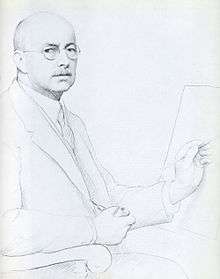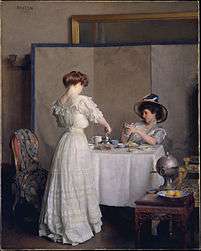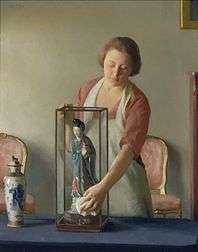William McGregor Paxton
| William McGregor Paxton | |
|---|---|
 Self-portrait, c. 1910 | |
| Born |
June 22, 1869 Baltimore, Maryland |
| Died |
1941 Newton, Massachusetts |
| Nationality | American |
| Education | Cowles Art School, Jean-Léon Gérôme |
| Spouse(s) | Elizabeth Okie Paxton |
William McGregor Paxton (June 22, 1869 – 1941) was an American painter and instructor who embraced the Boston School paradigm and was a co-founder of The Guild of Boston Artists. He taught briefly while a student at Cowles Art School, where he met his wife Elizabeth Okie Paxton, and at the Museum of Fine Arts School in Boston. Paxton is known for his portraits, including those of two presidents—Grover Cleveland and Calvin Coolidge—and interior scenes with women, including his wife. His works are in many museums in the United States.
Early life
He was born on June 22, 1869 in Baltimore to James and Rose Doherty Paxton.[1] William's father moved the Paxton family and established a catering business in Newton Corner, Massachusetts in the mid-1870s.[2]
- Museum of Fine Arts, Boston
%2C_1902.jpg) Portrait of the Artist's Mother (Rose Paxton), 1902
Portrait of the Artist's Mother (Rose Paxton), 1902%2C_1902.jpg) Portrait of the Artist's Father (James Paxton), 1902
Portrait of the Artist's Father (James Paxton), 1902
Education
Paxton attended Cowles Art School on a scholarship he attained at the age of 18. He studied with Dennis Miller Bunker and Cowles and then went to Paris to study under Jean-Léon Gérôme,[2] at École des Beaux-Arts.[1] Maryhill Museum of Art said he also studied at Académie Julian in Paris.[3] He returned to Cowles and studied with Joseph DeCamp, who also taught Elizabeth Vaughan Okie.[2] She became Paxton's student and then his wife.[4][5]
Marriage
Paxton became engaged in 1896 to Elizabeth Vaughan Okie,[4][5] and they married on January 3, 1899.[1][6] They traveled to Europe together[4] and often spent their summers on Cape Cod and Cape Ann.[7] They lived in Newton, Massachusetts,[8] first on Elmwood Street with his parents.[2] About 1916 they resided or had a studio on Ipswich Street in Fenway Studios in Boston.[1] They later purchased a house in Newton Center on Montvale Road.[2]
- Paintings Paxton made of his wife, Elizabeth Okie Paxton
_The_White_Veranda_1902.jpg) The White Veranda, 1902
The White Veranda, 1902 The Red Fan, 1906, Maryhill Museum of Art
The Red Fan, 1906, Maryhill Museum of Art
Paxton's wife managed his career[9] and modeled for many of his works,[10] like the painting in which she was dressed for the ball.[11] "William McGregor Paxton... benefited from an art-savvy wife who supported his career, using her energy in the bet that his offered the more secure future," said author and art historian Rena Tobey. The couple had no children.[9]
Career
Paxton taught from 1906 to 1913 at the Museum of Fine Arts School [2] and painted at Fenway Studios in Boston.[1] He is primarily known for his portraits[2] and painted both Grover Cleveland[1] and Calvin Coolidge.[12] Maryhill Museum of Art says of his artistry, "Paxton was well known for the attention he gave to the effects of light and detail in flesh and fabric. His works often present idealized views of women, such as this portrait (The Red Fan) of his wife Elizabeth",[3] like Henry James's portrayal of women in his novels The Portrait of a Lady (1881) or The American (1877). His models, often daughters and wives of his patrons, were depicted as refined, cultured women of "conspicuous leisure", and equated with the "precious aesthetic objects surround them", like the women of Thorstein Veblen's Theory of the Leisure Class (1899) who reflect the wealth of their husbands or fathers.[13] He crafted elaborate compositions with models in his studio, using props that appear in several paintings.[14]
Paxton and several other Bostonian artists were inspired by Johannes Vermeer.[3] The Metropolitan Museum of Art says of Paxton's Tea Leaves (1909) in their collection:
In a windowless parlor permeated by soft light, a dreamy atmosphere, and the sounds of silence, two elegant women pass the time by doing very little or nothing at all. Paxton hints at a narrative, but he asks that the viewer invent it, recapitulating the ambiguity of Vermeer's paintings, which he admired.[13]
 In the studio, 1905
In the studio, 1905 Tea Leaves, oil on canvas, 1909, Metropolitan Museum of Art
Tea Leaves, oil on canvas, 1909, Metropolitan Museum of Art Girl combing her hair or Young girl with a mirror, 1909,
Girl combing her hair or Young girl with a mirror, 1909, William McGregor Paxton, The New Necklace, 1910, Museum of Fine Arts, Boston
William McGregor Paxton, The New Necklace, 1910, Museum of Fine Arts, Boston The Figurine, 1921, Smithsonian American Art Museum
The Figurine, 1921, Smithsonian American Art Museum
Paxton employed a technique where only one area in his compositions was entirely in focus, while the rest was somewhat blurred, something he called "binocular vision" and credited to Vermeer. He began to employ this system in his own work, including The New Necklace, where only the gold beads are sharply defined while the rest of the objects in the composition have softer, blurrier edges.[15]
Paxton is one of the key figures in the Boston School of painting and a co-founder of The Guild of Boston Artists with Frank Weston Benson and Edmund Charles Tarbell.[2] Between 1926 and 1927, he was interviewed by Dewitt Lockman with 85 other artists and architects associated with the National Academy of Design. Records from the interview are held at the New York Historical Society and the Archives of American Art.[16] Paxton was made a full member of the National Academy of Design in 1928.[17]
Paxton died of a heart attack when he was painting his wife in their Montvale Road living room. He was 72 years of age.[2] An exhibition was held in his memory at the Museum of Fine Arts, Boston from November 19 through December 14, 1941.[18] His papers—including sketches, correspondence, and photographs—are held at the Archives of American Art at the Smithsonian Institution in Washington, D.C.[19]
Collections
|
|
References
- 1 2 3 4 5 6 Albert Nelson Marquis (1915). Who's who in New England. A.N. Marquis. p. 830.
- 1 2 3 4 5 6 7 8 9 "William McGregor Paxton (1869-1941)". Historic Newton. Newton, Massachusetts government. Retrieved September 27, 2014.
- 1 2 3 4 "William McGregor Paxton, "The Red Fan"". Highlights from the Collection. Maryhill Museum of Art. Retrieved September 27, 2014.
- 1 2 3 Hirshler, Erica E. (2001). A Studio of Her Own: Women Artists in Boston, 1870-1940. Boston: Museum of Fine Arts Publications. p. 189.
- 1 2 Panama-Pacific International Exposition. 1915. Dept. of Fine Arts (1915). Official Catalogue of the Department of Fine Arts, Panama-Pacific International Exposition (with Awards) San Francisco, California. Wahlgreen Company. p. 169.
- ↑ Carol Lowrey (2007). A Legacy of Art: Paintings and Sculptures by Artist Life Members of the National Arts Club. Hudson Hills. p. 164. ISBN 978-0-615-15499-2.
- ↑ "Elizabeth Vaughn Okie Paxton (1877-1971)". Historic Newton. Newton, Massachusetts government. Retrieved September 26, 2014.
- ↑ The Artists Year Book: A Handy Reference Book Wherein May be Found Interesting Data Pertaining to Artists, and Their Studio, Home and Summer Addresses. Art League Publishing Association. 1905. p. 150.
- 1 2 Rena Tobey (Summer 2014). "Art Essay: Elizabeth Okie Paxton and The Breakfast Tray: The Modernity of a New Woman Artist". Art Times. Retrieved September 26, 2014.
- ↑ Paxton, William McGregor; Paxton, Elizabeth Okie. "William Paxton Papers, 1886-1971". Archives of American Art Journal.
- ↑ Honor Moore (18 May 2009). The White Blackbird: A Life of the Painter Margarett Sargent by Her Granddaughter. W. W. Norton. p. 87. ISBN 978-0-393-34437-0.
- 1 2 "Calvin Coolidge". National Portrait Gallery, Smithsonian Institution. Retrieved September 27, 2014.
Calvin Coolidge, 1939, oil on canvsas, Union League of Philadelphia
- 1 2 "Tea Leaves". Metropolitan Museum of Art. Retrieved September 27, 2014.
- ↑ Davis; et al. (2003), MFA Highlights: American Painting, Boston
- ↑ "The New Necklace". Museum of Fine Arts, Boston. Retrieved September 27, 2014.
- ↑ "Interviews of artists and architects associated with the National Academy of Design, 1926-1927". Archives, Manuscripts and Documents. Smithsonian Institution. Retrieved September 27, 2014.
- ↑ "Academian - P". National Academy of Design. Retrieved September 27, 2014.
- ↑ "William McGregor Paxton, N.A. Memorial exhibition of paintings. Museum of Fine Arts, Boston, November 19 through December 14, 1941.". Smithsonian Libraries. Retrieved September 26, 2014.
- ↑ "William McGregor Paxton papers, 1886-1971". Archives, Manuscripts, Photographs Catalog. Smithsonian Institution Research Information Systems. Retrieved September 27, 2014.
- ↑ "William McGreger Paxton". Brooklyn Museum. Retrieved September 27, 2014.
- ↑ "Sylvia, William McGregor Paxton". Butler Institute of American Art. Retrieved September 27, 2014.
- ↑ "Search Collection: William McGregor Paxton". Cleveland Museum of Art. Retrieved September 27, 2014.
- ↑ "Search: Paxton". Davis Museum and Cultural Center. Retrieved September 27, 2014.
- ↑ "Woman Sewing, William McGregor Paxton". Detroit Institute of Arts. Retrieved September 27, 2014.
- ↑ "William McGregor Paxton". Indianapolis Museum of Art. Retrieved September 27, 2014.
- ↑ "Search: William McGregor Paxton". Metropolitan Museum of Art. Retrieved September 27, 2014.
- ↑ "Search: William McGregor Paxton". Museum of Fine Arts, Boston. Retrieved September 27, 2014.
- ↑ "Search: Waitress". National Academy of Design. Retrieved September 27, 2014.
- ↑ "William McGregor Paxton". Pennsylvania Academy of the Fine Arts. Retrieved September 27, 2014.
- ↑ "William McGregor Paxton". Princeton University Art Museum. Retrieved September 27, 2014.
- ↑ "William McGregor Paxton". Sheldon Museum of Art, University of Nebraska–Lincoln. Retrieved September 27, 2014.
- ↑ "William McGregor Paxton". Smithsonian American Art Museum. Retrieved September 27, 2014.
| Wikimedia Commons has media related to Leonar. |
Further reading
- Exhibition catalogs
- William McGregor Paxton (1919). Exhibition of Paintings by William McGregor Paxton. Folsom Galleries.
- Museum of Fine Arts, Boston; Frank William Buxton; Robert Hale Ives Gammell (1941). William McGregor Paxton, N. A. Memorial Exhibition of Paintings: Museum of Fine Arts, Boston, November 19 Through December 14, 1941. Printed at the Harvard University Press.
- William McGregor Paxton, 1869-1941: (Member of the National Academy). Indianapolis Museum of Art. 1979.
- Books
- Robert Hale Ives Gammell (1986). The Boston Painters, 1900-1930. Parnassus Imprints. ISBN 978-0-940160-31-6.
External links
![]() Media related to William McGregor Paxton at Wikimedia Commons
Media related to William McGregor Paxton at Wikimedia Commons
- William McGregor Paxton, National Portrait Gallery, Washington, D.C.
- William McGregor Paxton Smithsonian Institution, Art Inventories Catalog
| Wikimedia Commons has media related to William McGregor Paxton. |